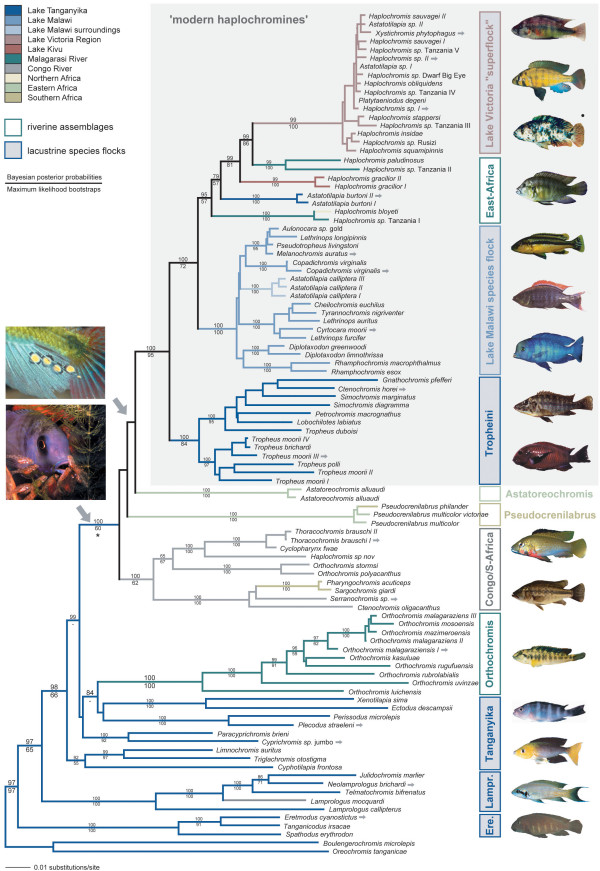Figure 3.
Maximum likelihood phylogeny of the haplochromine cichlids [general time-reversible model with gamma correction] based on 100 taxa. Numbers above the branches represent Bayesian posterior probabilities obtained with Mr. Bayes, numbers below the branches represent maximum-likelihood bootstraps (100 replicates, obtained with PAUP*). Boulengerochromis microlepis and Oreochromis tanganicae, two tilapiine cichlids in LT, were used as outgroup taxa [9, 15, 16, 63]. In accordance to previous studies [9, 15] we find that within the LT species flock the Eretmodini (Ere.) are placed as sister group to the Lamprologini (Lampr.) plus several LT tribes ("Tanganyika") including the Orthochromis assemblage from the Malagarasi plains, and the haplochromines sensu lato. The latter clade combines four distinct lineages, a Congolese/South-African- (CSA; ~150 species), the Pseudocrenilabrus- (3 species), the Astatoreochromis-lineage (3 species), and the modern haplochromines (~1,800 species). The modern haplochromines combine the LT Tropheini, the species flock of LM, several riverine lineages as well as the LV region superflock according to [4]. The haplochromines sensu lato are characterized by their breeding behavior; true egg-spots (ocelli) are likely to have evolved in the ancestor of the Astatoreochromis-lineage and the modern haplochromines. By contrast, the Malagarasi River Orthochromis are biparental caregivers [34] providing behavioral support for our molecular-based classification that excluded these fish from the haplochromines sensu lato. We note that several genera are polyphyletic and major taxonomic revisions will be required in the future to take our phylogenetic results into consideration. For example, Orthochromis of the Malagarasi River plains form a clade outside the remaining haplochromines in close affinity to the LT Ectodini (see also [9]) whereas Orthochromis polyacanthus and O. stormsi, which share derived features [12], fall – in accordance to their distribution – into the Congolese/South African clade. Other polyphyletic genera are Astatotilapia, Ctenochromis, and Haplochromis. The grey arrows next to some species names refer to the pictures on the right, the asterisk symbol marks the ancestor of the haplochromines sensu lato, the circle symbol marks a "piebald" ("orange blotched") form as found in the modern haplochromines only.

